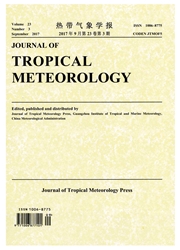

 中文摘要:
中文摘要:
在一个 Meiyu 正面的重降雨事件的中央规模和小规模的错误的空间繁殖,在 46 2003 年 7 月期间发生在东方中国,被使用 mesoscale 调查数字模型 MM5。一般来说,模仿的错误的空间繁殖取决于他们的水平规模。小规模(L < 100 km ) 起始的错误可以通过声波作为一个各向同性的圆很快传播。然后,许多散布传送对流规模错误在将进一步更通过各向同性的、塑造回合的声波在国外传播的潮湿的传送对流地区被触发。相应于降雨系统的进化,几个新传送对流规模错误可以被潮湿的传送对流在宣传塑造回合的错误以内连续地产生。通过上述圆形的过程,小规模的错误在振幅增加并且很快在规模成长。Mesoscale (100 km < L < 1000 km ) 起始的错误通过严肃波浪宣传在上游、下游的 wavelike,同时由吝啬的流动与降雨系统一起慢慢地下游地移居。因为它能在没有潮湿的传送对流的一个地方局部地积累错误精力, mesoscale 错误的在上游的繁殖对错误生长很重要并且从起始的不安来源远在上游。
 英文摘要:
英文摘要:
The spatial propagation of meso-and small-scale errors in a Meiyu frontal heavy rainfall event,which occurred in eastern China during 4-6 July 2003,is investigated by using the mesoscale numerical model MM5.In general,the spatial propagation of simulated errors depends on their horizontal scales.Small-scale(L 〈 100 km) initial error may spread rapidly as an isotropic circle through the sound wave.Then,many scattered convection-scale errors are triggered in moist convection zone that will spread abroad through the isotropic,round-shaped sound wave further more.Corresponding to the evolution of the rainfall system,several new convection-scale errors may be generated continuously by moist convection within the propagated round-shaped errors.Through the above circular process,the small-scale error increases in amplitude and grows in scale rapidly.Mesoscale(100 km 〈 L 〈 1000 km) initial error propagates up-and down-stream wavelike through the gravity wave,meanwhile migrating down-stream slowly along with the rainfall system by the mean flow.The up-stream propagation of the mesoscale error is very important to the error growth because it can accumulate error energy locally at a place where there is no moist convection and far upstream from the initial perturbation source.Although moist convection plays an important role in the rapid growth of errors,it has no impact on the propagation of meso-and small-scale errors.The diabatic heating could trigger,strengthen,and promote upscaling of small-scale errors successively,and provide "error source" to error growth and propagation.The rapid growth of simulated errors results from both intense moist convection and appropriate spatial propagation of the errors.
 同期刊论文项目
同期刊论文项目
 同项目期刊论文
同项目期刊论文
 期刊信息
期刊信息
